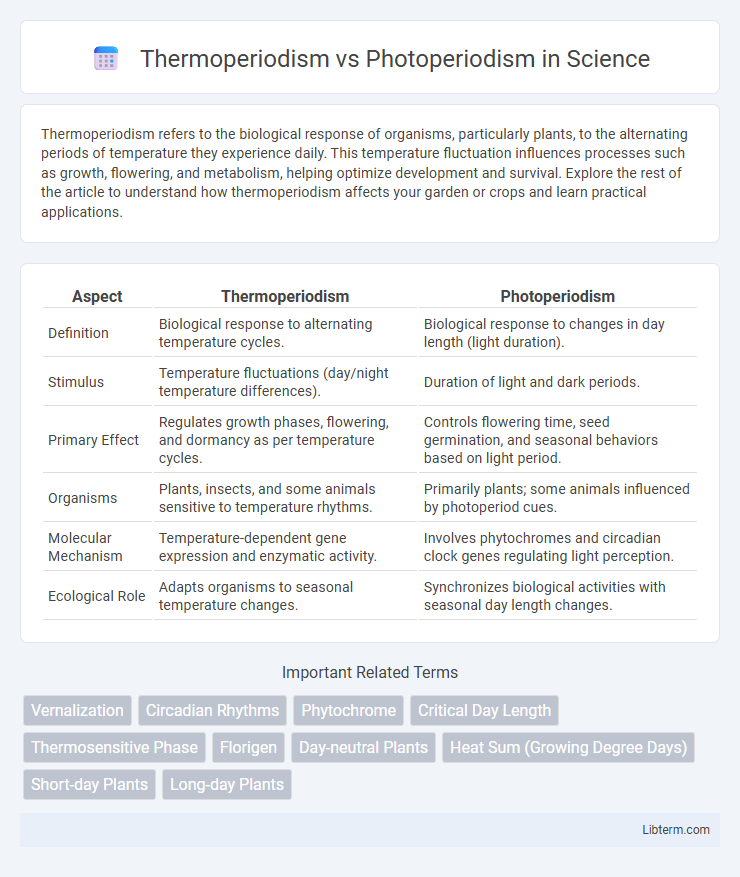Thermoperiodism refers to the biological response of organisms, particularly plants, to the alternating periods of temperature they experience daily. This temperature fluctuation influences processes such as growth, flowering, and metabolism, helping optimize development and survival. Explore the rest of the article to understand how thermoperiodism affects your garden or crops and learn practical applications.
Table of Comparison
| Aspect | Thermoperiodism | Photoperiodism |
|---|---|---|
| Definition | Biological response to alternating temperature cycles. | Biological response to changes in day length (light duration). |
| Stimulus | Temperature fluctuations (day/night temperature differences). | Duration of light and dark periods. |
| Primary Effect | Regulates growth phases, flowering, and dormancy as per temperature cycles. | Controls flowering time, seed germination, and seasonal behaviors based on light period. |
| Organisms | Plants, insects, and some animals sensitive to temperature rhythms. | Primarily plants; some animals influenced by photoperiod cues. |
| Molecular Mechanism | Temperature-dependent gene expression and enzymatic activity. | Involves phytochromes and circadian clock genes regulating light perception. |
| Ecological Role | Adapts organisms to seasonal temperature changes. | Synchronizes biological activities with seasonal day length changes. |
Introduction to Thermoperiodism and Photoperiodism
Thermoperiodism refers to an organism's biological response to cyclic temperature changes, influencing growth, development, and flowering in plants. Photoperiodism is the physiological reaction of plants to the length of day and night, regulating processes such as flowering and dormancy. Both mechanisms are crucial for adapting to seasonal variations and optimizing reproductive success.
Defining Thermoperiodism
Thermoperiodism refers to the physiological response of plants to alternating temperature cycles during a 24-hour period, influencing growth and developmental processes such as flowering and dormancy. Unlike photoperiodism, which depends on the duration of light and dark periods to regulate plant behavior, thermoperiodism relies primarily on temperature fluctuations between day and night. These temperature variations affect enzymatic activity and metabolic pathways, enabling plants to synchronize their life cycle events with environmental conditions.
Understanding Photoperiodism
Photoperiodism refers to the physiological response of organisms to the length of day and night, influencing processes such as flowering, dormancy, and reproduction in plants and animals. This phenomenon is regulated by the plant hormone phytochrome, which detects changes in light duration, enabling species to synchronize growth cycles with seasonal variations. Understanding photoperiodism is crucial for optimizing crop production, as manipulating light exposure can control flowering times and improve yield efficiency.
Key Differences Between Thermoperiodism and Photoperiodism
Thermoperiodism refers to the physiological and developmental responses of plants to alternating temperature cycles, while photoperiodism involves responses to changes in day length or light duration. Key differences include thermoperiodism's influence on processes such as seed germination and flowering based on temperature fluctuations, whereas photoperiodism primarily regulates flowering time and growth according to light exposure. Both mechanisms are crucial for plant adaptation but operate through distinct environmental cues--thermal cycles for thermoperiodism and light cycles for photoperiodism.
Mechanisms Behind Thermoperiodic Responses
Thermoperiodism involves plant responses to temperature cycles, where fluctuating temperatures regulate growth, flowering, and developmental processes through thermal signaling pathways and circadian clock interactions. Key mechanisms include temperature-sensitive molecular sensors, such as phytochromes and heat shock proteins, which modulate gene expression and hormonal balance in response to thermal variations. Unlike photoperiodism, which depends on light duration and quality, thermoperiodism relies primarily on diurnal temperature changes to synchronize physiological activities.
Photoperiodic Regulation in Plants and Animals
Photoperiodic regulation in plants involves the detection of light duration by phytochrome and cryptochrome photoreceptors, controlling processes such as flowering, dormancy, and growth cycles based on day length variations. In animals, photoperiodism governs seasonal behaviors including reproductive cycles, migration, and hibernation through melatonin secretion influenced by retinal photoreceptors and the suprachiasmatic nucleus in the brain. Understanding these mechanisms enables optimization of agricultural practices and wildlife management by manipulating light exposure to regulate developmental and behavioral responses.
Biological Significance of Thermoperiodism
Thermoperiodism refers to the physiological response of organisms to daily temperature fluctuations, which plays a crucial role in regulating plant growth, flowering, and metabolism independently of light cycles. This biological mechanism helps plants synchronize developmental processes with optimal environmental temperatures, enhancing survival and reproductive success in variable climates. Thermoperiodism influences seed germination, leaf expansion, and enzyme activity, thereby maintaining homeostasis and improving adaptability in fluctuating thermal conditions.
Ecological Impact of Photoperiodism
Photoperiodism regulates critical ecological processes such as flowering, migration, and reproduction by sensing day length changes, ensuring species synchronize their life cycles with seasonal variations. This adaptation enhances survival by aligning growth and reproductive phases with optimal environmental conditions, influencing ecosystem productivity and biodiversity. In contrast, thermoperiodism primarily responds to temperature fluctuations, but photoperiodism's role in ecological timing is more integral to maintaining seasonal rhythms in diverse habitats.
Applications in Agriculture and Horticulture
Thermoperiodism influences plant growth by regulating temperature cycles, optimizing seed germination, flowering, and fruit development in crops like rice and wheat, enhancing yield and stress resilience. Photoperiodism controls flowering and dormancy periods by detecting day length, crucial for scheduling planting dates and selecting crop varieties in horticulture such as chrysanthemums and soybeans. Combining thermoperiodism and photoperiodism management improves crop scheduling, yield quality, and adaptation to climate variability in agricultural systems.
Future Research Directions in Environmental Cue Responses
Future research in thermoperiodism will explore the molecular mechanisms by which temperature fluctuations influence gene expression and plant developmental stages, enhancing crop resilience under climate change. Photoperiodism studies are likely to focus on decoding the interaction between light-sensing proteins and circadian rhythms to optimize flowering time and yield in diverse ecosystems. Integrative approaches combining thermoperiodic and photoperiodic responses will develop predictive models for plant adaptation, critical for sustainable agriculture in shifting environmental conditions.
Thermoperiodism Infographic

 libterm.com
libterm.com